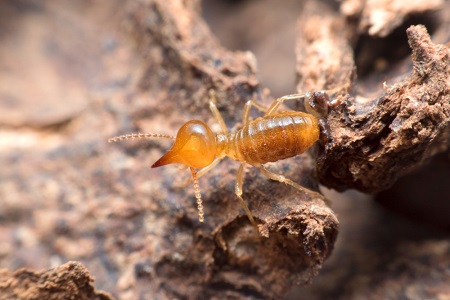Potential Threats to Concrete Structures: Termites and Their Intrusion
 Many who live in houses made of brick or concrete assume that they do not have to worry about termite infestations and damage. The reasoning behind this is that termites do not eat these materials - they only eat wood. Therefore, they assume that they are safe. But the truth is not quite so simple. While it is true that termites do not eat concrete or brick, just about every building, especially houses, will have some wood or cellulose materials in them. And that is what termites look for and feast on. This can cause all kinds of damage if termite prevention treatment is not done.
Many who live in houses made of brick or concrete assume that they do not have to worry about termite infestations and damage. The reasoning behind this is that termites do not eat these materials - they only eat wood. Therefore, they assume that they are safe. But the truth is not quite so simple. While it is true that termites do not eat concrete or brick, just about every building, especially houses, will have some wood or cellulose materials in them. And that is what termites look for and feast on. This can cause all kinds of damage if termite prevention treatment is not done.
How It Happens
While the use of bricks and concrete does reduce the amount of wood used in construction, it does not eliminate it. There will still be wood in the walls, the window frames and the doors and in places like the attic and basement. Wood can also, in some cases, run down to the floor slab and attract the attention of subterranean termites which live underground but climb upwards to reach any possible wooden food source. There may also be wooden strips, known as furring, placed inside concrete walls to make a mounting surface for attaching drywall. These are open invitations for termites to enter and spread throughout a structure. Wood treatment to prevent termites is the only way to avoid these dangers.
Also Read: Keep Your Pets Safe During Fumigation
Another type of termite, known as drywood termites, does not even require wooden contact with the ground to gain entry into a concrete or brick structure. These insects travel in swarms through the air and gain entry into a building through any opening above ground level. The attic is a common entry point and once in here, the termites work their way downwards in search of wood to feed on.
Points of Entry
- When the concrete in the foundation is drying, or when the soil under the structure settles, minute cracks appear in the concrete. These are not structural hazards, but they do provide a point of access for termites. Termites are known to travel under carpeting to reach walls where they start to feed on studs and wooden sills.
- Expansion joints must be located where concrete slabs meet. Some parts of the structure like bay windows, patios, carports and garages may have slabs that are separate from the main building. Termites use these gaps to gain entry.
- Concrete slabs often have holes to allow pipes to enter. Unless these openings are tightly and completely sealed, the gaps between the pipe and the concrete are enough for termites to get in.
Also Read: How to Have a Termite - Free New Year
Once termites are in, you will often find tiny tubes of mud on the interior or exterior walls which are used as passages to search for sources of food. Contact a professional termite control service to learn more about the importance of soil treatment for termites.
The longer the termites remain in a house, irrespective of the type of material it is made of, the more damage they will cause and the greater the subsequent repair bill. Spotting the signs of a termite infestation in the early stages so that action can be taken to get rid of the infestation and prevent termites’ re-entry requires the expert knowledge and expertise of a professional termite control company. No home is safe from termites unless it has received termite prevention treatment.
- Jan 23, 2024
